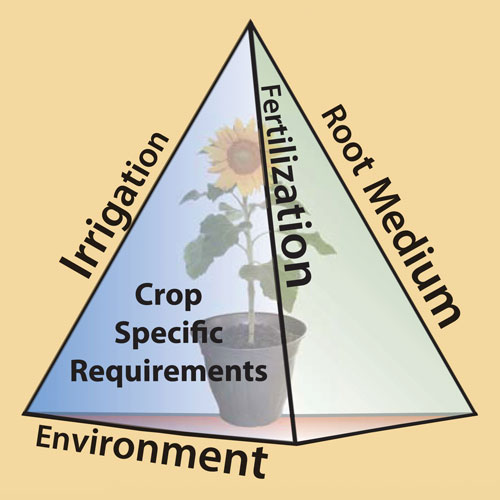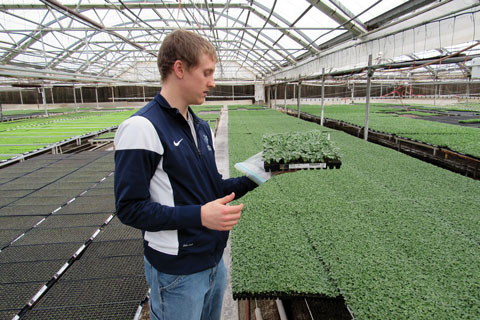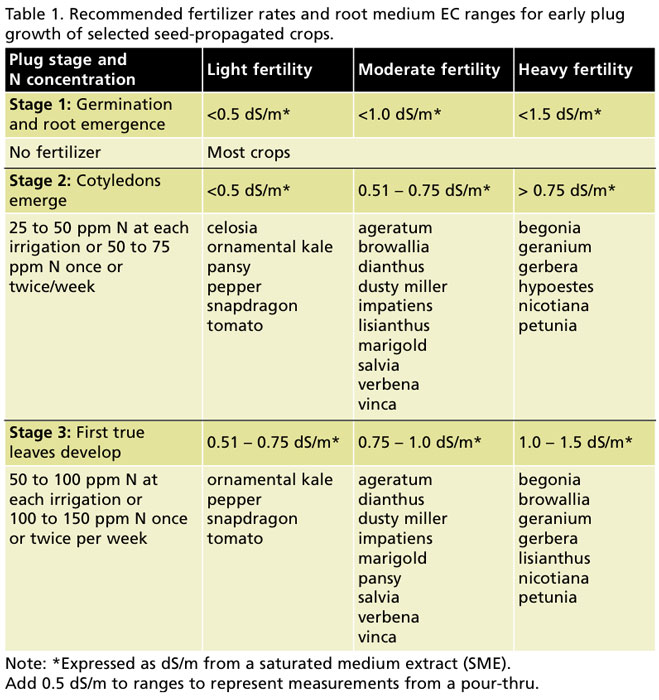9/1/2018
Back to Basics
Kimberly A. Williams, Donald J. Merhaut & Salvatore S. Mangiafico
Most growers know, as a matter of intuition and experience, that their fertilization program, irrigation practices, root medium characteristics and environmental variables are interrelated: a change in one affects the performance of the others.
For example, your water quality influences your fertilization program, and if you change your root medium, it influences how you irrigate. How the complexities of water and nutrient management are intrinsically related to each other—and how this affects plug and cutting quality—can be visualized as the Nutrient Management Pyramid (Figure 1). Fertilization, irrigation, root medium characteristics and environmental conditions comprise its four sides and the requirements of the particular crop, such as pH preference or stage of development, are in the center.
 Figure 1. The nutrient management pyramid has fertilization, irrigation, root medium characteristics and environmental variables on its four sides. Each of these must be matched to the requirements of a particular crop in order to assure successful production. If one component is altered, a change in other components is often necessary.
Figure 1. The nutrient management pyramid has fertilization, irrigation, root medium characteristics and environmental variables on its four sides. Each of these must be matched to the requirements of a particular crop in order to assure successful production. If one component is altered, a change in other components is often necessary.
If a change is made to a component on one side of the pyramid, crop requirements may necessitate a change in a component on another side to preserve the growth, health and appearance of the crop. Changes in environmental variables—such as light, temperature or humidity—affect young plant water and nutrient needs, which in turn require adjustment to mist, irrigation and fertilization practices, and sometimes even root medium composition. Successful nutrient and water management require that these four components of the growing process be examined closely. This is especially important when growers need to customize production practices for a particular crop or solve a production problem.
Consistent root medium handling and irrigation
To apply this conceptual water and nutrient management framework to the daily task of irrigating and fertilizing, growers should have the goal of integrating their root medium choices, fertilization program and irrigation practices into a complete, fine-tuned production system. To begin, start with consistent, repeatable root medium handling and irrigation practices, but keep the root medium mix and fertilization program flexible enough to optimize production for individual crops or production situations.
Consistent, repeatable root media handling means:
• Fill plug trays uniformly.
• Avoid compaction. Compaction reduces air space, increases the chance of overwatering, contributes to lack of uniformity in a tray and reduces a root medium’s ability to provide water and nutrients to the young plants—especially in the small volume of plug cells.
• Add about 100% moisture by weight to the mix before filling containers. For a sphagnum peat-vermiculite germination mix, this translates to roughly 20 gal. of water per 1 yd3 of mix. If excess shrinkage occurs in the plug tray after watering-in, chances are good that the moisture content of the medium was too low during tray filling.
• Lightly fill pots or flats and brush the excess root medium away. Do not nest containers on top of each other such that the root medium becomes compressed.
Consistent, repeatable irrigation practices mean:
• Apply the irrigation solution evenly and uniformly. Taking the time to occasionally calibrate booms or characterize the spray pattern from overhead nozzles provides knowledge to reduce variability that occurs in your production space. Plug trays can be weighed to determine moisture levels that guide decisions about irrigation frequency (Figure 2).
• Maintain consistent water quality. Water should be low in salts and contaminants, with an alkalinity level that can be managed. Treating water or changing or blending water sources is necessary for young plant production if a water source isn’t of excellent quality.
Once the basic production system is designed, implemented and maintained, it can be altered as needed for specific crops or situations. Changes may be needed to meet seasonal needs, optimize nutrient management for specific crop species or solve production problems that repeatedly occur.

Flexible root medium and fertilizer programs
Flexible root medium and fertilizer programs allow for different root medium amendments or fertilizer formulations, depending on seasons of the year or crop-specific needs. This often includes root media with adjusted lime rates or fertilizer selections based on crop pH preference.
Figure 2. Plug trays are weighed at Tagawa Greenhouses in Brighton, Colorado, to guide irrigation decisions about how frequently to irrigate.
Iron-inefficient crops—such as calibrachoa, pansy and petunia—are prone to iron deficiency and perform best with a root medium pH of 5.4 to 6.0 to keep iron more soluble and more available for uptake by plants. Less pre-plant lime and use of acidifying and high iron fertilizer formulations will help avoid iron deficiency in these crops.
On the other hand, iron-efficient crops—such as zonal geranium and marigold—require a root medium pH of 6.0 to 6.6 to avoid iron and manganese toxicity. The soluble fertilizer chosen for crops in this group should not acidify the root medium and have a high basicity value if other measures aren’t taken to increase root medium pH, such as increasing the rate of pre-plant dolomitic lime in the root medium.
A flexible fertilizer program allows nutrient rate applied to be adjusted based on stage of crop development. Recently germinated seedlings require very little in the way of nutrients because they rely on nutrient stores from the seed, but once the true leaves and roots begin to expand, nutrient rates should gradually increase.
The ideal plug fertilization program results in a healthy, high-quality plug that will rapidly establish after it’s transplanted. When recently transplanted plugs fail to “take off,” a culprit is often found to be too little fertilizer during plug production. (Table 1 provides fertilizer levels by crop species and plug growth stage.)
 Some plug growers use a pulse or interval feeding program, alternating weekly or twice-weekly fertilizer applications with clear water irrigation. This strategy helps avoid salt buildup in plug cells. Another strategy is to continuously provide a lower level of nutrients with every irrigation to ensure that the rapidly growing plug always has access to nutrients.
Some plug growers use a pulse or interval feeding program, alternating weekly or twice-weekly fertilizer applications with clear water irrigation. This strategy helps avoid salt buildup in plug cells. Another strategy is to continuously provide a lower level of nutrients with every irrigation to ensure that the rapidly growing plug always has access to nutrients.
Reality check
But let’s be realistic: a young plant operation must balance the needs of hundreds of different crop species with relatively short production cycles in the same production space. Iron inefficient versus efficient crops can be grouped and sown into root media with different starting pH. Most young plant growers keep their fertilizer program relatively simple, such as a single fertilizer formulation matched to their water quality for use with most crops and altering the frequency of application to control soluble salts levels.
Consider the following flexible nutrient management program described by one young plant producer: once plugs have true leaves, after Stage 2, a “pass” of the irrigation boom applies a standard 125 ppm N, then plain irrigation water is used. Their standard fertilizer is 13-2-13 with Ca and Mg at rates from 100 to 150 ppm N. When the cloudiness of winter arrives, they switch to a low ammonium- and higher nitrate-N blend of 14-4-14.
As the season progresses and light intensity increases, the operation rotates in a 17-2-17 formulation to provide a bit higher ammonium-N and potassium. A micronutrient blend with additional K and P is continuously fed through the overhead irrigation system throughout the operation. This strategy enables the operation to use a complete fertilizer with lower phosphorus because there’s some phosphorus in the irrigation water.
This is a perfect example of applying the Nutrient Management Pyramid to production of the myriad of young plant species in one production operation—consistent, repeatable root medium handling and irrigation practices, but with flexible root medium and fertilization programs. Production decisions are all inter-related and recognizing these inter-relationships and the effects that they have on plug and cutting quality is a cornerstone of exceptional crop quality. GT
Kimberly A. Williams is Professor of Greenhouse Management at Kansas State University; Donald Merhaut is Associate Extension Specialist for Ornamental and Floriculture Crops at University of California-Riverside; and Salvatore Mangiafico is Associate Professor and County Extension Head at Rutgers, The State University of New Jersey, Cooperative Extension. They are co-editors of the new book “Water, Root Media, and Nutrient Management for Greenhouse Crops” available from anrcatalog.ucanr.edu. This comprehensive and user-friendly manual has chapters written by over 20 different greenhouse industry professionals and academics.